Flamingos are familiar birds even to those who have never seen them in real life or had much interest in birds. Their long curvy necks, long legs and pink colour make flamingos a spectacle of joy.
Whether you see the big colony of Flamingos in the shallow waters trying to get food, or you see them in flight, they are spectacular animals.
In this article, we shall take a look at some facts that make flamingos even more interesting than what you see when you look at them.
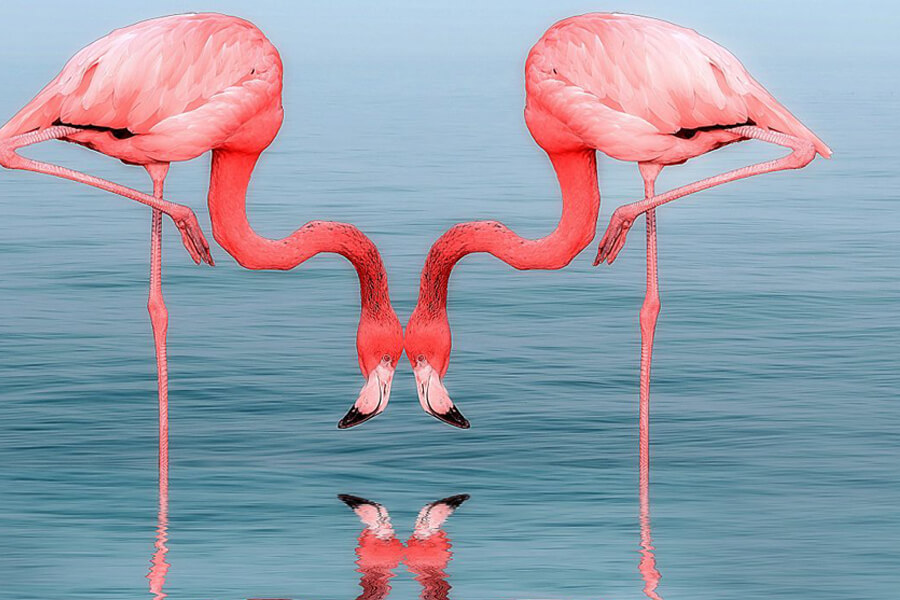
Fascinating Facts About Flamingos
1. There Are 6 Kinds Of Flamingos
There are 6 living species of flamingos that live in various parts of Africa, Asia, Europe, North America and South America.
| # | FLAMINGO SPECIES | HABITAT RANGE |
|---|---|---|
| 1. | Greater Flamingo | Parts of Africa, Southern Europe, Southern & Southwestern Asia |
| 2. | Lesser Flamingo | Africa, Northwest India |
| 3. | Chilean Flamingo | Temperate South South America |
| 4. | James's Flamingo | The high Andes in Peru, Chile, Bolivia, Argentina |
| 5. | Andean Flamingo | The high Andes in Peru, Chile, Bolivia, Argentina |
| 6. | American Flamingo | Caribbean Islands, Caribbean Mexico, S. Florida, Coastal Colombia, N Brazil, Venezuela, Galapagos Islands |
The Greater Flamingo is the most widespread of all flamingo species whereas the lesser flamingo is the most populous in numbers.
2. Habitat Range Of Flamingos
Flamingos usually live in mudflats and shallow coastal lagoons filled with saltwater. These areas are rich in algae which is a rich food for the insects and crustaceans, which make up a major portion of the flamingo's diet.
In Africa, you can find flamingos in countries such as Uganda, Kenya, Tanzania, Botswana, and South Africa among others. They also inhabit parts of Asia, including India and the Middle East. In the Americas, they are commonly seen in places like Mexico, the United States (especially Florida), and various parts of South America.
It is clear from the wide habitat range that flamingos are among the best adaptable larger birds in the whole world. And the dash of natural pink is a welcome addition to these various landscapes.
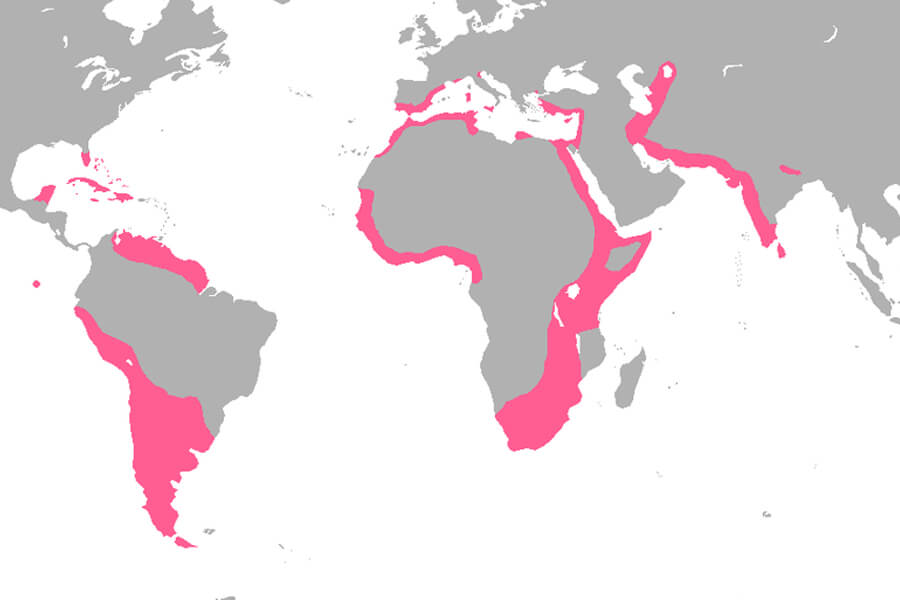
3. Flamingo Means 'Flame Colored'
The name "flamingo" is believed to have its origins in both the Spanish word "flamenco" and the Portuguese word "Flamengo," both of which mean "flame-coloured" or "fire." This name is very fitting because it reflects the vibrant pink or reddish hue of the bird's plumage.
4. Why Are Flamingos Pink In Color?
Flamingos owe their pink colour to their diet. Their primary food source consists of tiny organisms like algae and crustaceans that contain pigments called carotenoids.
These carotenoids are rich in red and orange hues. When flamingos consume these organisms over time, the carotenoids accumulate in their feathers and skin, giving them their distinctive pink colour.
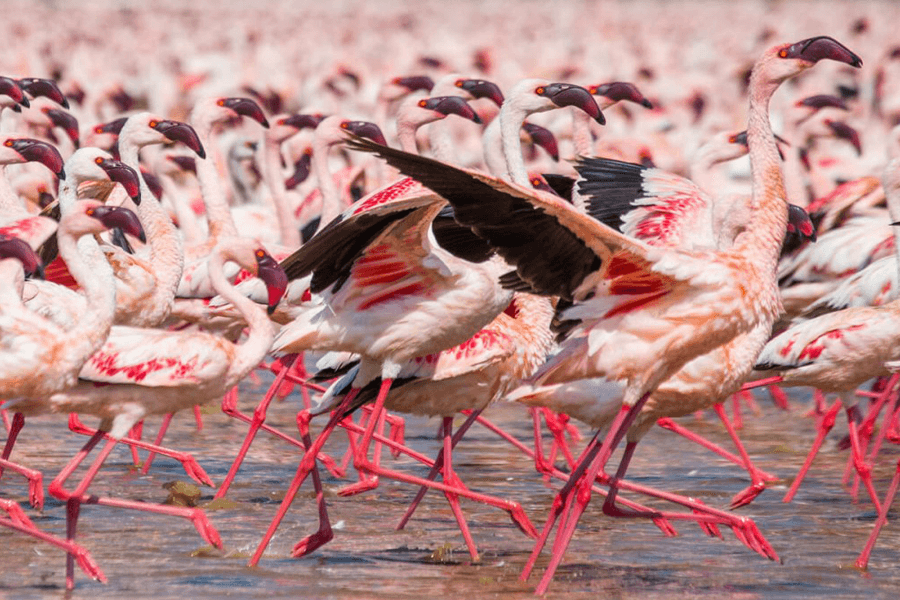
Without these carotenoids in their diet, flamingos will turn while. This can at times happen at the zoo or other captive environments where the diet might not have much of this pigment.
Whether you call them white birds that become pink due to food, or pink birds that turn white when their food isn't very good - their colour is a big part of how we see them.
5. Size, Weight & Wingspan
Flamingos come in various sizes depending on the species, but on average, they stand about 3 to 5 feet (0.9 to 1.5 meters) tall with a wingspan of 4.5 to 5 feet (1.4 to 1.5 meters).
In terms of weight, they typically weigh between 3 to 6.5 pounds (1.4 to 3 kilograms). These tall, elegant birds are known for their slender build and long legs and necks.
Here's a table showing the sizes and weights of various flamingo species
| FLAMINGO SPECIES | HEIGHT RANGE | WINGSPAN RANGE | WEIGHT RANGE |
|---|---|---|---|
| Greater Flamingo | 4.3 to 5.6 feet | 5.2 to 6.6 feet | 4.4 to 9.9 pounds |
| Lesser Flamingo | 2.6 to 3.3 feet | 3.3 to 3.6 feet | 3.3 to 6.6 pounds |
| Chilean Flamingo | 3.6 to 4.1 feet | 3.9 to 4.2 feet | 4.4 to 8.8 pounds |
| American Flamingo | 3.6 to 4.6 feet | 4.3 to 4.6 feet | 4.4 to 7.7 pounds |
| Andean Flamingo | 3.6 to 4.2 feet | 3.9 to 4.2 feet | 4.4 to 8.8 pounds |
Keep in mind that sizes can be smaller or bigger than the average due to many factors in the bird's environment.
For Comparison to other big birds, Marabou storks can stand as tall as 6 feet (1.8 meters) and weigh 15 to 20 pounds (7 to 9 kilograms). In as much as a flamingo might not come off as one of the big birds in size, the greater flamingo is not much smaller than the Marabou stork, and they are both perfectly built to dominate the land and air.
6. Flamingos Sleep While Standing - On One Leg.
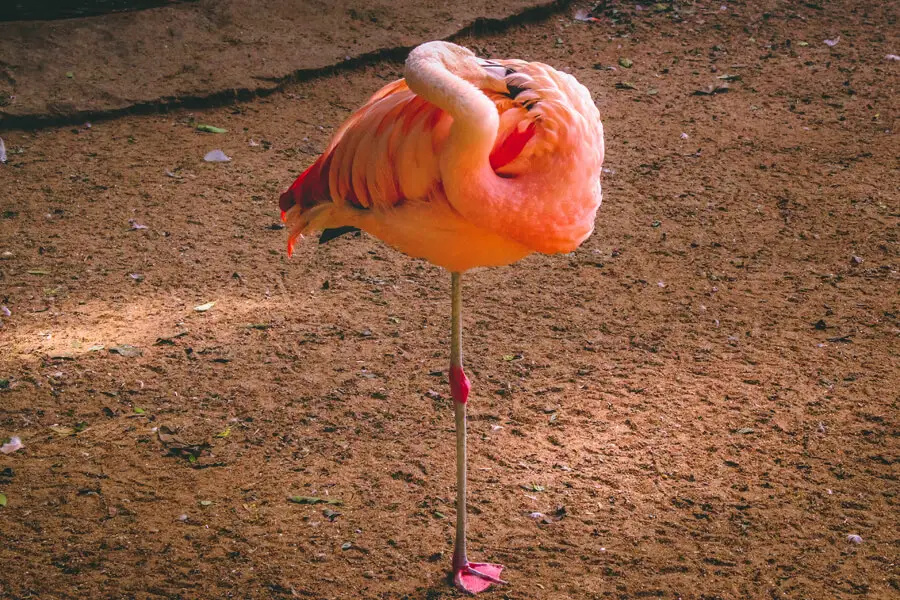
Flamingos typically sleep while standing on one leg. This is probably one of the most usual ways of resting but flamingos have evolved to do it so well enough to conserve energy and avoid predators.
Flamingos do this by tucking one of the legs under their body and balancing on just one. They periodically rotate the legs so that each one gets to rest.
Given the precision involved in balancing on one leg, any threat or abrupt movement can easily be detected and reacted to. Since they sleep in big groups, this provides a sense of collective security and an effective alarm system in case of any danger in the whole group.
7. Flamingos Are Great At Flying.
While flamingos are often seen in shallow waters, they are capable of flying. Their light build and elongated proportions are as ideal in the air as they are in shallow saltwater.

A Flamingo can fly at great heights of even more than 15,000 feet in the air. Flamingos have been observed flying at speeds of 50 to 60 kilometres per hour, as well as covering distances of up to 600 kilometres in a single day.
While these are impressive numbers, it is clear that flamingos are not the master of endurance when it comes to flying. Similar to cheetahs, being lightweight and aerodynamic means a great sacrifice for endurance.
To understand how impressive this is, the average helicopter and small aeroplane can fly up to around 10000 feet in the air. This means a flamingo flying at its maximum, would still be 5000 feet (1.5 kilometres) above advanced aircraft
8. Flamingos Eat Everything
Flamingos have a diverse omnivorous diet that primarily includes small invertebrates like shrimp, crabs, molluscs, and insects. They also eat algae and aquatic plants such as filamentous algae, water lilies, and duckweed.
Flamingos also use their specialized bill to filter food from the water and capture very small organisms and particles. They also ingest silt and mud, which can contain additional nutrients.
Depending on where they live and what food is available, the flamingo's diet can differ.
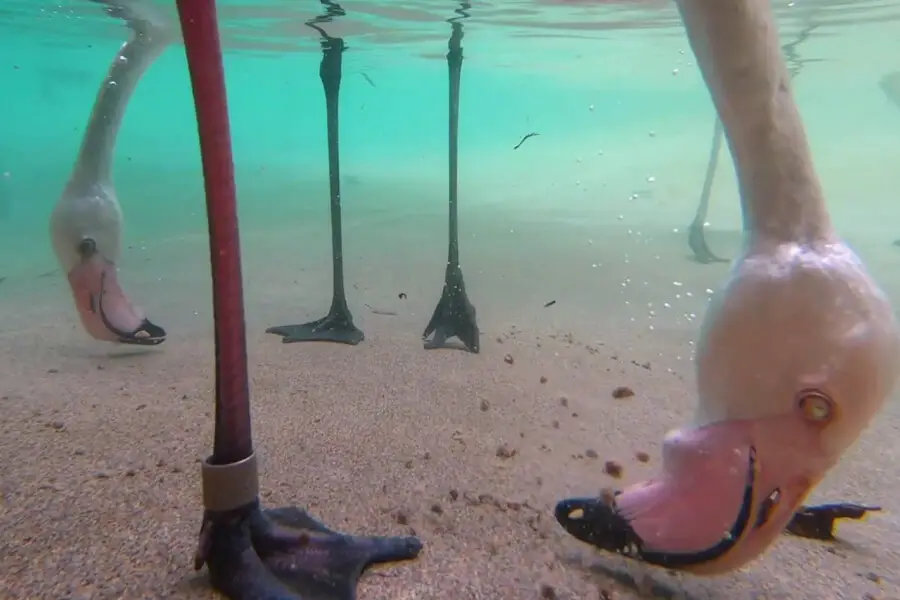
9. Flamingos Eat Upside Down
Flamingos feed by bending their long necks downward and submerging their heads in shallow water, creating the appearance of eating upside down.
They lower their long necks, put their heads underwater, and use their beaks like strainers. Their beaks and tongues are lined with a hair-like structure (lamellae) that helps in filtering out the mud from the food.
This helps them catch tiny water creatures like shrimp and algae to eat. It might look like they're eating upside down because their heads are underwater while their bodies stay up.
The flamingos' way of feeding is often described as 'filter feeding'.
10. Flamingos Produce Crop Milk.
Flamingos have a special way of feeding their chicks a milk-like secretion. This is called crop milk and is produced in the flamingo's crop.
Both male and female flamingos produce crop milk which is then regurgitated to nourish their chicks. It is comprised of a rich blend of fats, proteins, and essential nutrients that are necessary for providing a complete diet for the developing chicks.
Typically the flamingos will produce crop milk for a period ranging from a couple weeks to a few months after the hatching of their young ones. The chicks will gradually transition to solid food until they can completely feed on their own.
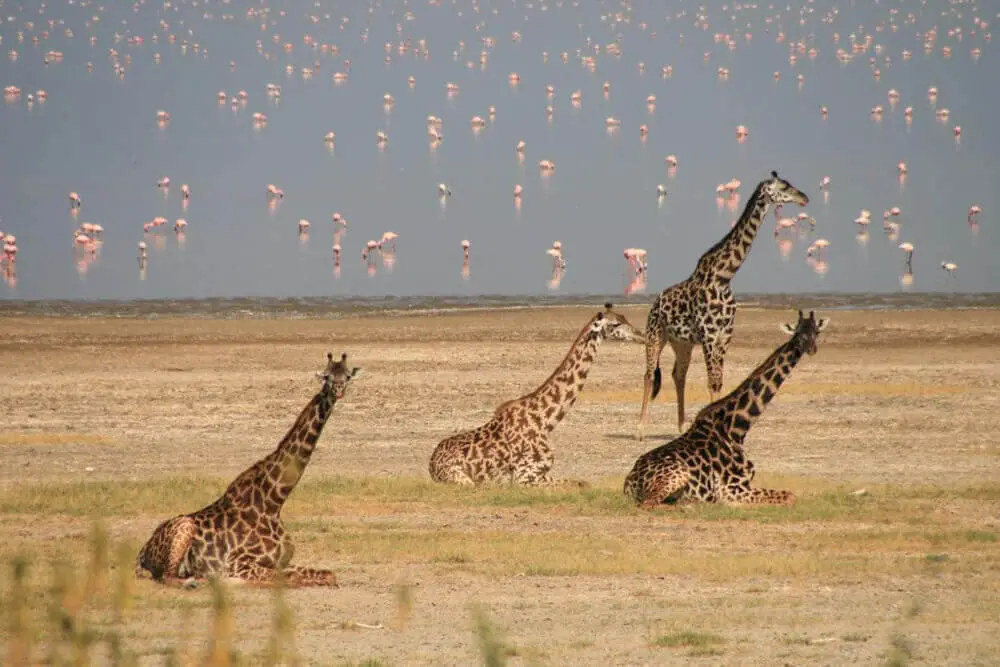
11. A Flamoboyance Of Flamingos.
A group of flamingos is most commonly called a flamboyance. The other names for a group of flamingos include terms such as flock, regiment, flurry, stand and colony among others. Admittedly, flamboyance is more fitting and great for starting a conversation about birds.
Flamingos are highly social birds and a flamboyance can be formed of thousands of birds. These social habits serve many purposes from safety, and communication to cooperative feeding and much more.
12. Flamingos Form Strong Mating Bonds.
Flamingos form strong and enduring mating bonds, that are crucial to their social and reproductive lives.
During the breeding season, they establish pairs through elaborate courtship displays, often remaining monogamous for that season or longer. These bonded pairs work together to build nests, share the responsibility of incubating their eggs, and actively participate in raising their chicks.
This shared parental care strengthens their partnership and contributes to the overall social structure within large breeding colonies.
13. Flamingos Live Longer Than Lions
In the wild, flamingos normally live for 20 to 30 years. In captivity where they have access to constant food, protection from predators and good veterinary care, flamingos live much longer, many of them reaching up to 50 years.
In 2014, a greater flamingo that died at the Adelaide Zoo in Australia was said to be 83 years old.
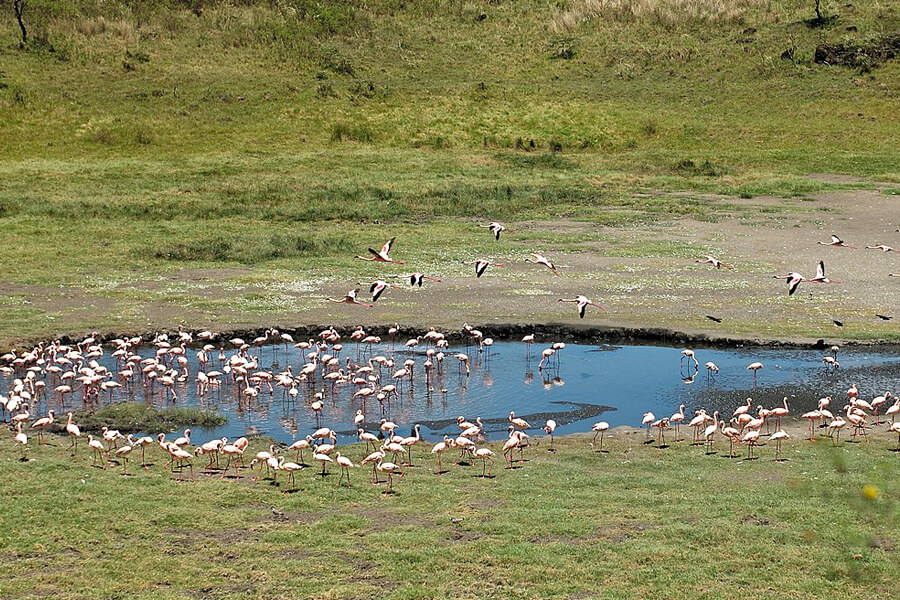
Regardless of their lifespan in captivity, flamingoes are still living longer than most of the fierce African animals in the wild - including favourites like lions.
Related article: Lifespan of various African animals
14. Conservation Status
According to the International Union for the Conservation of Nature (IUCN), Flamingos are not under any imminent threat of extinction. They are regarded as Least Concern, which means that their numbers and distribution are stable.
As with most other wild species, Flamingos also face the threat of human activity that keeps shrinking their habitat. Water pollution also kills the marine ecosystem which they rely on for food.
Final Thoughts
Every time we learn more about an animal, there is always something that surprises us. It is the uniqueness of every animal that makes up the beauty of the ecosystem and environment they live in.
Flamingos are very unique birds that can live as long as elephants and yet are ironically weightless.
Whether you see flamingos at a zoo or in the wild, the sight is spectacular. We hope you enjoyed learning about flamingos and that you will get to see them soon.
